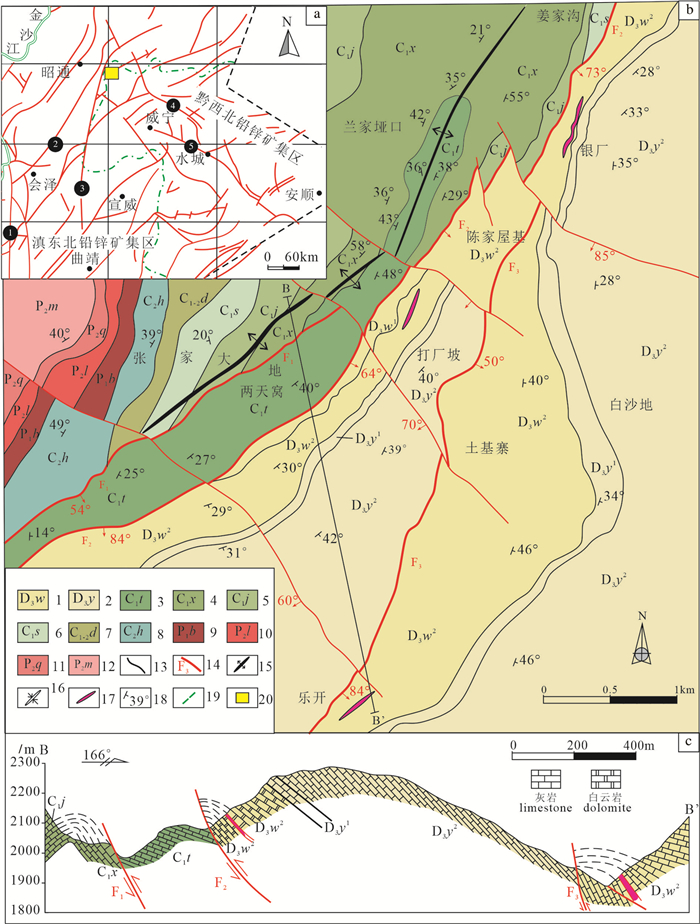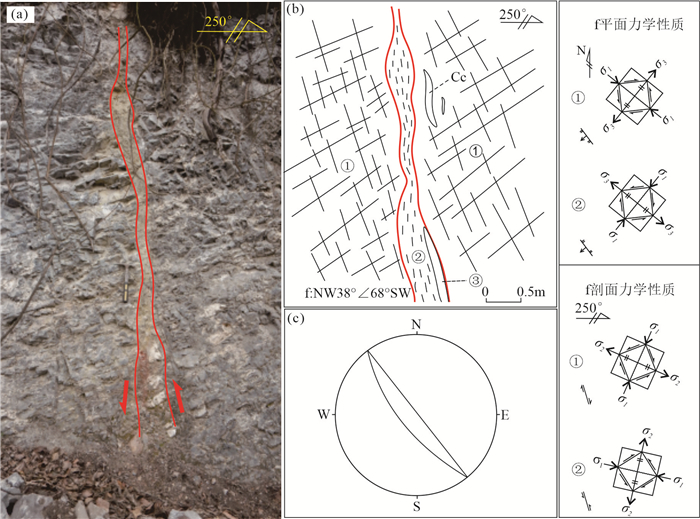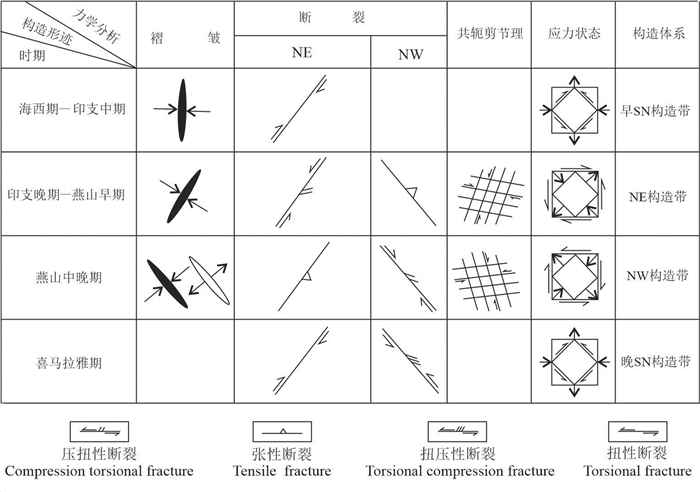Tectono-geochemistry and deep prospecting prediction in the Lekai lead-zinc deposit, Northwestern Guizhou Province, China
-
摘要:
研究目的 乐开铅锌矿床是近些年黔西北铅锌矿集区内新发现的矿床之一,与该矿集区内铅锌矿床主要受NW向断裂控制有所不同,乐开铅锌矿床严格受NE向断褶构造控制,与滇东北矿集区铅锌矿床具有一致的成矿地质条件。该研究对黔西北乐开地区乃至川滇黔接壤区铅锌矿深部找矿具有重要的指示意义。
研究方法 主要包括构造精细解析和构造地球化学等方法。
研究结果 该区控矿构造型式为典型的“多字型”和“入字型”,并划分出3种构造组合,分别代表 4种不同的构造体系:海西期—印支中期(早SN构造带)、印支晚期—燕山早期(NE构造带)、燕山中晚期(NW构造带)及喜马拉雅期(晚SN构造带)。断裂构造岩主要表现为低温成矿阶段的前缘晕元素组合(Sb-As-Hg)、中温成矿阶段的近矿晕元素组合(Zn-Pb-Cd)与中高温成矿阶段的尾晕元素组合(In-Sn-Ni-Cu)。
结论 NE构造带为该矿床的成矿构造体系,推断成矿流体在平面上自SW向NE向运移,提出矿区深部6个定位找矿靶区。
Abstract:This paper is the result of mineral exploration engineering.
Objective The Lekai lead-zinc deposit, located in the Pb-Zn deposit concentration of northwestern Guizhou, is one of the small-scale lead-zinc deposits newly discovered in recent years. Different from most lead-zinc deposits in the Pb-Zn deposit concentration of northwestern Guizhou, the Lekai lead-zinc deposit is controlled strictly by NE trending fault-fold structure, which is similar to most lead-zinc deposits in the Pb-Zn deposit concentration of northeastern Yunnan. The current research provided significant implications for the deep exploration in the Lekai lead-zinc deposit and the Sichuan–Yunnan–Guizhou Triangle area (SYGT).
Methods This study applied a large deal of detailed structural analysis on mechanical properties for faults and folds in the mining area and tectono-geochemistry method.
Results The results showed that duo-type and λ-type are the main ore-controlling structural styles in this area. Moreover, three tectonic associations have been divided, which are correspond to four tectonic systems, namely Hercynian to Mid Indosinian, Late Indosinian to Early Yanshanian, Mid-Late Yanshanian, and Himalayan epochs. The trace elements concentrations of tectonites represented three element associations of principal factors, including frontal halo elements (Sb-As-Hg) in low temperature ore-forming stage, mineralization-halo elements (Zn-Pb-Cd) in medium-low temperature ore-forming stage, and tail-halo elements (In-Sn-Ni-Cu) in medium temperature ore-forming stage.
Conclusions In four tectonic systems, ore-forming tectonic system corresponded with Late Indosinian to Early Yanshanian. According to anomaly features and their distribution regularities, the possible migration direction of ore-forming fluid is from southwest to northeast, and six target prospecting areas have been put forward in the depth of mining.
-

-
图 1 a—乐开铅锌矿床地质简图;b—川滇黔区域地质图(据柳贺昌, 1995修改);c—矿区BB’实测地质剖面图
Figure 1.
表 1 乐开铅锌矿床构造岩因子分析方差极大旋转因子载荷矩阵
Table 1. Varimax rotation factor load matrix for tectonites in Lekai lead-zinc deposit

-
Cheng Chen, Han Runsheng, Wang Lei, Xiao Xianguo, He Zhiwei, Li Bo, Zhou Xuanling. 2019. The generation, development and ore-controlling of structures of the Fulaichang lead-zinc deposit, northeastern Guizhou[J]. Journal of Geomechanics, 25(1): 90-104(in Chinese with English abstract).
Cheng Penglin, Xiong Wei, Zhou Gao, He Zhiwei. 2015. A preliminary study on the origins of ore-forming fluids and their migration directions for Pb-Zn Deposits in NW Guizhou Province, China[J]. Acta Mineralogica Sinica, 35(4): 509-514(in Chinese with English abstract).
Han Runsheng, Liu Congqiang, Ma Deyun, Ma Gensheng, Hu Bin. 2001. Fault tectono-geochemical features and ore-forming prognosis of orientation in Tongchang ore-field, Tongchang, Shaanxi[J]. Geology-Geochemistry, 29(3): 158-163(in Chinese with English abstract). doi: 10.3969/j.issn.1672-9250.2001.03.028
Han Runsheng. 2003. Preliminary discussion on research contents and methods of tectono-metallogenic dynamics and concealed ore orientation prognosis[J]. Geology and Exploration, 39(1): 5-9(in Chinese with English abstract).
Han Runsheng. 2005. Orefield/deposit tectono-geochemical method for the localization and prognosis of concealed orebodies[J]. Geology and Exploration, 24(10/11): 978-984(in Chinese with English abstract).
Han Runsheng, Liu Congqiang, Huang Zhilong, Chen Jin, Ma Deyun, Lei Li, Ma Gengsheng. 2007. Geological features and origin of the Huize carbonate-hosted Zn-Pb-(Ag) district, Yunnan, South China[J]. Ore Geology Reviews, 31: 360-383. doi: 10.1016/j.oregeorev.2006.03.003
Han Runsheng, Hu Yuzhao, Wang Xuekun, Hou Baohong, Huang Zhilong, Chen Jin, Wang Feng, Wu Peng, Li Bo, Wang Hongjiang, Dong Ying, Lei Li. 2012. Mineralization model of rich Ge-Ag-bearing Zn-Pb polymetallic deposit concentrated district in Northeastern Yunnan, China[J]. Acta Geologica Sinica, 86(2): 280-294(in Chinese with English abstract). doi: 10.3969/j.issn.0001-5717.2012.02.007
Han Runsheng. 2013. Main study progress for ten years of tectono-geochemistry[J]. Bulletin of Mineralogy, Petrology and Geochemistry, 32(2): 198-203(in Chinese with English abstract). doi: 10.3969/j.issn.1007-2802.2013.02.005
Han Runsheng, Wang Feng, Hu Yuzhao, Wang Xuekun, Ren Tao, Qiu Wenlong, Zhong Kanghui. 2014. Metallogenic tectonic dynamics and chronology constrains on the Huize-type (HZT) germanium-rich silver-zinc-lead deposits[J]. Geotectonica et Metallogenia, 38(4): 758-771(in Chinese with English abstract). doi: 10.3969/j.issn.1001-1552.2014.04.003
Han Runsheng, Chen Jin, Wang Feng, Wang Xuekun, Li Yuan. 2015. Analysis of metal-element association halos within fault zones for the exploration of concealed ore-bodies——A case study of the Qilinchang Zn-Pb-(Ag-Ge) deposit in the Huize mine district, northeastern Yunnan, China[J]. Journal of Geochemical Exploration, 159(11): 62-78.
Han Runsheng, Zhang Yan, Wang Feng, Wu Peng, Qiu Wenlong, Li Wenyao. 2017. Metallogenic Mechanism and Concealed Ore Orientation Prognosis of Rich Ge-Ag-bearing Zn-Pb Polymetallic Deposit Concentrated District in Northeastern Yunnan[M]. Beijing: Science Press, 125-196(in Chinese).
Han Runsheng, Wu Peng, Wang Feng, Zhou Gaoming, Li Wenyao, Qiu Wenlong. 2019. "Four Steps Type" ore-prospecting method for deeply concealed hydrothermal ore deposits——A case study of the Maoping Zn-Pb (Ag-Ge) deposit in southwestern China. Geotectonica et Metallogenia, 43(2): 246-257(in Chinese with English abstract).
Han Runsheng, Wang Mingzhi, Jin Zhongguo, Li Bo, Wang Ziyong. 2020. Ore-controlling mechanism of NE-trending ore-forming structural system at Zn-Pb polymetallic ore concentration area in northwestern Guizhou[J]. Acta Geologica Sinica, 94(3): 850-868(in Chinese with English abstract). doi: 10.3969/j.issn.0001-5717.2020.03.013
Hu Bin, Han Runsheng. 2003. The ore-controlling structure and ore-prospecting direction of Maoping lead-zinc deposit[J]. Yunnan Geology, 22(3): 295-303(in Chinese with English abstract). doi: 10.3969/j.issn.1004-1885.2003.03.008
Jin Zhongguo. 2008. Research on the Ore-controlling Factors, Metallogenic Regularity an Prediction of Lead-Zinc Ore District in Northwest, Guizhou[M]. Beijing: Metallurgical Industry Press, 1-109(in Chinese).
Liu Hechang. 1995. Tectonic ore-control in Yunnan-Sichuan-Guizhou lead-zinc mining areas[J]. Yunnan Geology, 14(3): 173-189(in Chinese with English abstract).
Liu Yingjun, Cao Liming, Li Zhaolin, Wang Henian, Chu Tongqing, Zhang Jinrong. 1984. Element Geochemistry[M]. Beijing: Science Press, 1-548(in Chinese).
Lü Guxian, Sun Yan, Liu Deliang, Wu Xueyi, Liu Ruixun. 2011. Tectono-geochemistry: A review[J]. Geotectonica et Metallogenia, 35(4): 479-494(in Chinese with English abstract). doi: 10.3969/j.issn.1001-1552.2011.04.002
Pan Guitang, Xiao Qinghui, Lu Songnian, Den Jinfu, Feng Yimin, Zhang Kexin, Zhang Zhiyong, Wang Fangguo, Xing Guangfu, Hao Guojie, Feng Yanfang. 2009. Subdivision of tectonic units in China[J]. Geology in China, 36(1): 1-28(in Chinese with English abstract). doi: 10.3969/j.issn.1000-3657.2009.01.001
Qin Shourong, Liu Aimin. 1998. A discussion on the Himalayan tectonic movement in Guizhou[J]. Guizhou Geology, 15(2): 105-114(in Chinese with English abstract).
Qin Shourong, Zhang Mingfa, Gong Mei, Kuang Zhong. 2009. Indosinian movement in Guizhou[J]. Sedimentary Geology and Tethyan Geology, 29(2): 100-103(in Chinese with English abstract). doi: 10.3969/j.issn.1009-3850.2009.02.016
Shao Yue. 1997. Rock Measurements (Primary Halo Method) in the Hydrothermal Deposits Prospecting[M]. Beijing: Geological Publishing House, 1-62(in Chinese).
Song Danhui, Han Runsheng, Wang Feng, Wang Mingzhi, Zhou Wei, Luo Da. 2021. Structural ore-controlling mechanism and its implications for deep prospecting of Qingshan lead-zinc deposit in northwest Guizhou, China[J]. Geology in China. https://kns.cnki.net/kcms/detail/11.1167.P.20210104.1853.006.html (in Chinese with English abstract).
Sun Jiacong, Han Runsheng. 2016. Theory and Method of Ore-field Geomechanics[M]. Beijing: Science Press, 1-356(in Chinese).
Tu Guangchi. 1984. Tectonics and geochemistry[J]. Geotectonica et Metallogenia, 8(1): 1-5(in Chinese with English abstract).
Wang Mingzhi, Han Runsheng, Zhou Wei, Song Danhui, Luo Da, Zhou Jianfei, Wu Ruilin. 2019. Ore-forming structure analysis of the Liangyan Lead-zinc mining area in northwestern Guizhou deposit concentration district, China[J]. Journal of Geomechanics, 25(2): 187-197(in Chinese with English abstract).
Wu Kaibin, Jiang Kaiyuan, Huang Wenjun, Yue Lianhong, Zhang Deming. 2019. Tectonic formation features and its evolution in Nayong-Shuicheng area of northwest Guizhou[J]. Guizhou Geology, 36(2): 165-172(in Chinese with English abstract). doi: 10.3969/j.issn.1000-5943.2019.02.009
Xiao Xianguo, Huang Zhilong, Zhou Jiaxi, Jin Zhongguo, Li Xiaobiao, Zhang Lunwei. 2011. Several problems involved in genetic studies on the Pb-Zn deposits, northwest Guizhou Province, China[J]. Acta Mineralogica Sinica, 31(3): 419-424.
Xu Yaming, Liao Guixinag, Liao Liping. 2009. Geological and geochemical characteristics of multi-elements and prospecting criteria in northwestern Guizhou Province[J]. Journal of Jilin University (Earth Science Edition), 39(5): 818-823(in Chinese with English abstract).
Xu Zhengbang, Lou Yuanren. 1994. Foundation of Mathematical Geology[M]. Beijing: Geological Publishing House, 1-62(in Chinese).
Yu Weilai, Fan Liangwu. 2007. Geological charcteristics of typical lead-zinc deposits and pondering on ore prospecting in northwestern Guizhou Province[J]. Acta Mineralogica Sinica, 27(3/4): 461-465.
成晨, 韩润生, 王雷, 肖宪国, 何志威, 李波, 周暄翎. 2019. 黔西北福来厂铅锌矿床构造成生发展及其控矿作用[J]. 地质力学学报, 25(1): 90-104. https://www.cnki.com.cn/Article/CJFDTOTAL-DZLX201901038.htm
程鹏林, 熊伟, 周高, 何志威. 2015. 黔西北地区铅锌矿床成矿流体起源与运移方向初探[J]. 矿物学报, 35(4): 509-514. https://www.cnki.com.cn/Article/CJFDTOTAL-KWXB201504015.htm
韩润生, 刘丛强, 马德云, 马更生, 胡彬. 2001. 陕西铜厂地区断裂构造地球化学及定位成矿预测[J]. 地质地球化学, 29(3): 158-163. https://www.cnki.com.cn/Article/CJFDTOTAL-DZDQ200103027.htm
韩润生. 2003. 初论构造成矿动力学及其隐伏矿定位预测研究内容和方法[J]. 地质与勘探, 39(1): 5-9. https://www.cnki.com.cn/Article/CJFDTOTAL-DZKT200301002.htm
韩润生. 2005. 隐伏矿定位预测的矿田(床)构造地球化学方法[J]. 地质通报, 24(10/11): 978-984. https://www.cnki.com.cn/Article/CJFDTOTAL-ZQYD2005Z1018.htm
韩润生, 胡煜昭, 王学琨, Hou Baohong, 黄智龙, 陈进, 王峰, 吴鹏, 李波, 王洪江, 董英, 雷丽. 2012. 滇东北富锗银铅锌多金属矿集区矿床模型[J]. 地质学报, 86(2): 280-294. https://www.cnki.com.cn/Article/CJFDTOTAL-DZXE201202008.htm
韩润生. 2013. 构造地球化学十年主要进展[J]. 矿物岩石地球化学通报, 32(2): 198-203. https://www.cnki.com.cn/Article/CJFDTOTAL-KYDH201302005.htm
韩润生, 王峰, 胡煜昭, 王学琨, 任涛, 邱文龙, 钟康惠. 2014. 会泽型(HZT)富锗银铅锌矿床成矿构造动力学研究及年代学约束[J]. 大地构造与成矿学, 38(4): 758-771. https://www.cnki.com.cn/Article/CJFDTOTAL-DGYK201404003.htm
韩润生, 张艳, 王峰, 吴鹏, 邱文龙, 李文尧. 2017. 滇东北矿集区富锗铅锌矿床成矿机制与隐伏矿定位预测[M]. 北京: 科学出版社, 125-197.
韩润生, 吴鹏, 王峰, 周高明, 李文尧, 邱文龙. 2019. 论热液矿床深部大比例尺"四步式"找矿方法——以川滇黔接壤区毛坪富锗铅锌矿为例[J]. 大地构造与成矿学, 43(2): 246-257. https://www.cnki.com.cn/Article/CJFDTOTAL-DGYK201902005.htm
韩润生, 王明志, 金中国, 李波, 王子勇. 2020. 黔西北铅锌多金属矿集区成矿构造体系及其控矿机制[J]. 地质学报, 94(3): 850-868. https://www.cnki.com.cn/Article/CJFDTOTAL-DZXE202003013.htm
胡彬, 韩润生. 2003. 毛坪铅锌矿构造控矿及找矿方向[J]. 云南地质, 22(3): 295-303. https://www.cnki.com.cn/Article/CJFDTOTAL-YNZD200303007.htm
金中国. 2008. 黔西北地区铅锌矿控矿因素、成矿规律与找矿[M]. 北京: 冶金工业出版社, 1-109.
柳贺昌. 1995. 滇、川、黔铅锌成矿区的构造控矿[J]. 云南地质, 14(3): 173-189. https://www.cnki.com.cn/Article/CJFDTOTAL-YNZD503.000.htm
刘英俊, 曹励明, 李兆麟, 王鹤年, 储同庆, 张景荣. 1984. 元素地球化学[M]. 北京: 科学出版社, 1-548.
吕古贤, 孙岩, 刘德良, 吴学益, 刘瑞珣. 2011. 构造地球化学的回顾与展望[J]. 大地构造与成矿学, 35(4): 479-494. https://www.cnki.com.cn/Article/CJFDTOTAL-DGYK201104004.htm
秦守荣, 刘爱民. 1998. 论贵州喜山期的构造运动[J]. 贵州地质, 15(2): 105-114. https://www.cnki.com.cn/Article/CJFDTOTAL-GZDZ199802000.htm
秦守荣, 张明发, 龚梅, 况忠. 2009. 贵州的印支运动[J]. 沉积与特提斯地质, 29(2): 100-103. https://www.cnki.com.cn/Article/CJFDTOTAL-TTSD200902015.htm
邵跃. 1997. 热液矿床岩石测量(原生晕法)找矿[M]. 北京: 地质出版社, 1-62.
宋丹辉, 韩润生, 王峰, 王明志, 周威, 罗达. 2021. 黔西北青山铅锌矿床构造控矿机理及其对深部找矿的启示[J]. 中国地质. https://kns.cnki.net/kcms/detail/11.1167.P.20210104.1853.006.html.
孙家骢, 韩润生. 2016. 矿田地质力学理论与方法[M]. 北京: 科学出版社, 1-356.
涂光炽. 1984. 构造与地球化学[J]. 大地构造与成矿学, 8(1): 1-5. https://www.cnki.com.cn/Article/CJFDTOTAL-DGYK198401001.htm
王明志, 韩润生, 周威, 宋丹辉, 罗达, 周剑飞, 吴睿林. 2019. 黔西北矿集区亮岩铅锌矿区成矿构造解析[J]. 地质力学学报, 25(2): 187-197. https://www.cnki.com.cn/Article/CJFDTOTAL-DZLX201902059.htm
吴开彬, 蒋开源, 黄文俊, 跃连红, 张德明. 2019. 黔西北纳雍-水城一带构造变形特征及其演化[J]. 贵州地质, 36(2): 165-172. https://www.cnki.com.cn/Article/CJFDTOTAL-GZDZ201902009.htm
肖宪国, 黄智龙, 周家喜, 金中国, 李晓彪, 张伦尉. 2011. 黔西北铅锌矿床成因研究中的几个问题[J]. 矿物学报, 31(3): 419-424. https://www.cnki.com.cn/Article/CJFDTOTAL-KWXB201103016.htm
许亚明, 廖桂香, 廖莉萍. 2009. 黔西北地区多元素地球化学特征与找矿标志[J]. 吉利大学学报(地球科学版), 39(5): 818-823. https://www.cnki.com.cn/Article/CJFDTOTAL-CCDZ200905009.htm
徐振邦, 娄元仁. 1994, 数学地质基础[M]. 北京: 地质出版社, 1-226.
余未来, 范良伍. 2007. 黔西北地区典型铅锌矿床地质特征分析及找矿思路[J]. 矿物学报, 27(3/4): 461-465. https://www.cnki.com.cn/Article/CJFDTOTAL-KWXB2007Z1035.htm
-




 下载:
下载:









